Hummingbirds, the enchanting aerial artists of the avian world, captivate with their vibrant plumage, astonishing flight capabilities, and diminutive stature.
Renowned for their iridescent colors and rapid wing beats, hummingbirds are a distinct family within the avian kingdom, showcasing unparalleled agility and resilience.
The answer to what makes hummingbirds extraordinary is their unique adaptations, from hovering effortlessly to flying backward.
With a metabolism that rivals their frenetic wing beats, these small wonders play a vital role in ecosystems as pollinators, darting between blossoms in search of nectar.
As we delve into the intricate facets of their life history, nesting behaviors, and challenges, we are invited to explore the mesmerizing world of hummingbirds and the delicate balance they maintain in nature.
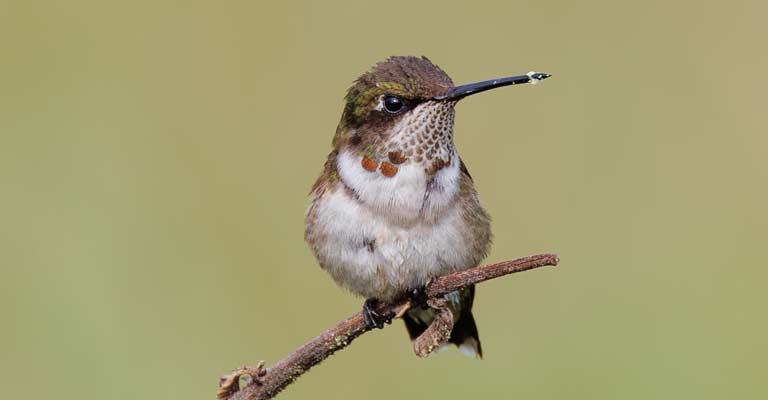
Identifying Characteristics of Hummingbirds
Hummingbirds are fascinating and enchanting birds known for their small size, vibrant colors, and astonishing flight capabilities.
Identifying these remarkable creatures requires attention to various distinctive characteristics, from physical appearance to unique behaviors.
Let’s delve into the key features that make hummingbirds easily distinguishable.
Size and Shape
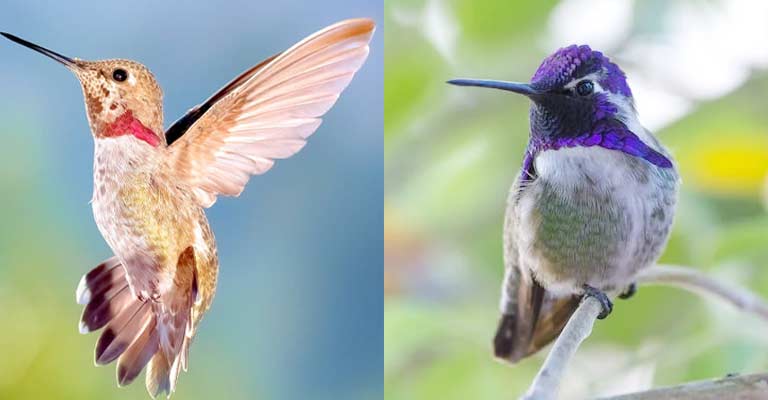
One of the primary characteristics of hummingbirds is their petite size. Most hummingbirds measure 3 to 5 inches in length, making them one of the smallest bird species in the world.
Their diminutive stature is complemented by a streamlined body, which is essential for their incredible agility during flight. A short neck, slender beak, and compact wings characterize the body structure.
Coloration
Hummingbirds are renowned for their vibrant and iridescent plumage. The dazzling colors on their feathers result from microscopic platelets that refract light, creating a spectrum of hues.
The color palette can include vivid greens, blues, reds, and purples. Males often boast more vivid and elaborate colors than females, as their plumage attracts mates and establishes dominance in their territory.
Distinctive Bill and Tongue
The specialized bill of a hummingbird is a crucial identifier. It is long, slender, and adapted for sipping nectar from flowers. The bill’s length allows it to reach deep into blossoms, while its tubular shape facilitates nectar extraction.
At the tip of the bill is the tubular, extensible tongue, which enables them to lap up nectar at an astonishing rate. The tongue’s structure is perfectly adapted to their unique feeding habits.
Flight Patterns
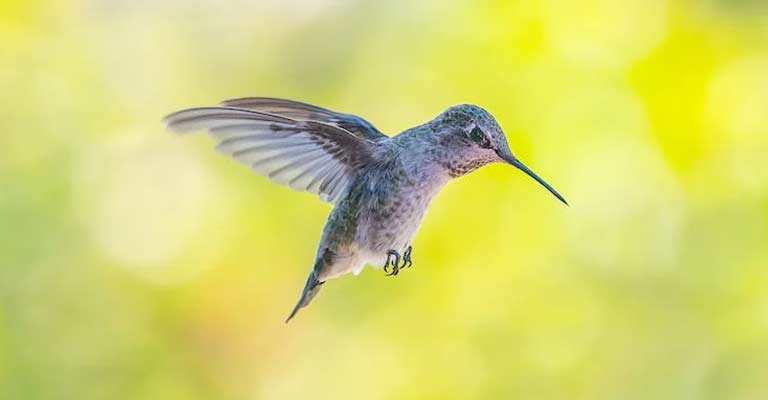
Observing the flight patterns of a bird is often an excellent method for identification. Hummingbirds are renowned for their unparalleled hovering abilities.
They can remain suspended in mid-air by rapidly flapping their wings in a figure-eight pattern, a feat unmatched by most other bird species.
Their wings beat astonishingly, often exceeding 50 beats per second, allowing them to dart and hover with exceptional precision.
Vocalizations
While not as harmonious as other bird species, hummingbirds produce distinct vocalizations. Their vocal repertoire includes high-pitched chirps, whistles, and buzzing sounds.
These vocalizations are often used for communication, especially during territorial disputes or courtship displays. Although not as prominent as their visual characteristics, recognizing hummingbird calls can aid identification.
Territorial Behavior
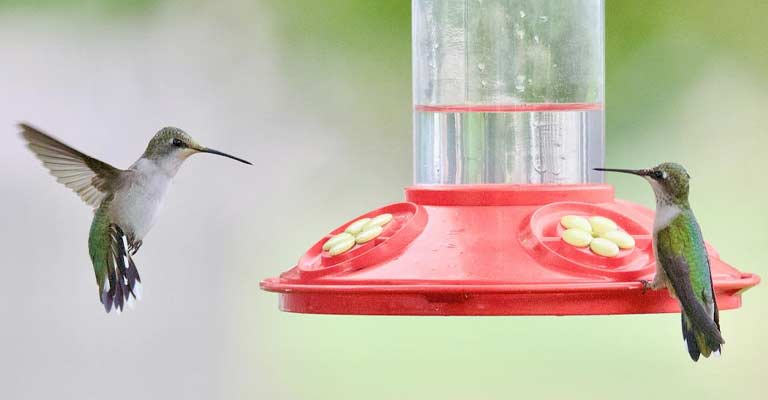
Hummingbirds are territorial creatures, and their behavior in defending a specific area can be an identifying trait. They vigorously guard territories, chasing away intruders with remarkable agility.
These territorial displays often involve aerial acrobatics and rapid chattering. Understanding their territorial tendencies can provide valuable insights into their identification.
Migration Patterns
Many hummingbird species are known for their remarkable migratory journeys. Understanding the migration patterns of hummingbirds in your region can be a key factor in identification.
Some species migrate thousands of miles between their breeding and wintering grounds. Knowing when hummingbirds are likely to be present in your area can assist in narrowing down potential species.
Identifying hummingbirds involves a combination of visual and behavioral characteristics.
Their small size, vibrant colors, specialized bill and tongue, unique flight patterns, vocalizations, territorial behavior, and migration patterns make these birds easily distinguishable.
Whether you’re a bird enthusiast or a casual observer, taking note of these key features will enhance your ability to identify and appreciate these remarkable creatures in the wild.
Taxonomy of Hummingbirds
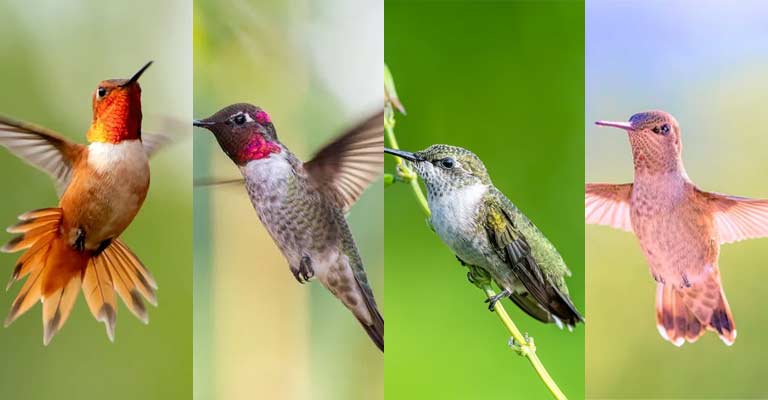
Here’s a table outlining the taxonomy details of hummingbirds:
| Taxonomic Level | Classification |
| Domain | Eukaryota |
| Kingdom | Animalia |
| Phylum | Chordata |
| Class | Aves |
| Clade | Strisores |
| Order | Apodiformes |
| Family | Trochilidae |
Here are the birds of the 28 similar species of Hummingbirds:
1. Mexican Violetear
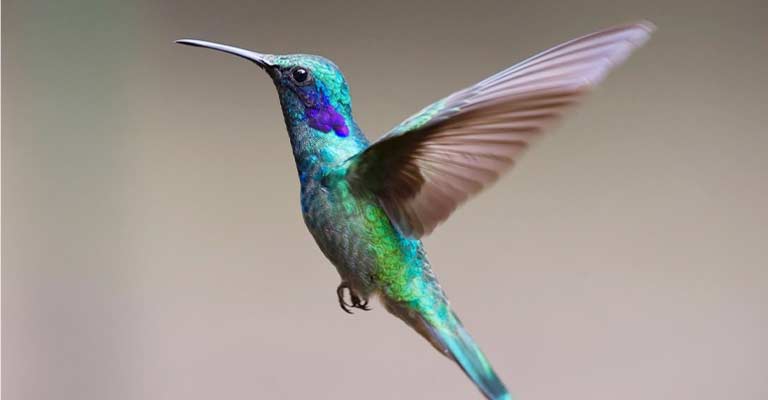
The Mexican Violetear, a striking hummingbird, flaunts vibrant violet plumage. Found in Mexico and Central America, it thrives in high-altitude habitats, sipping nectar with its specialized bill.
2. Green-breasted Mango
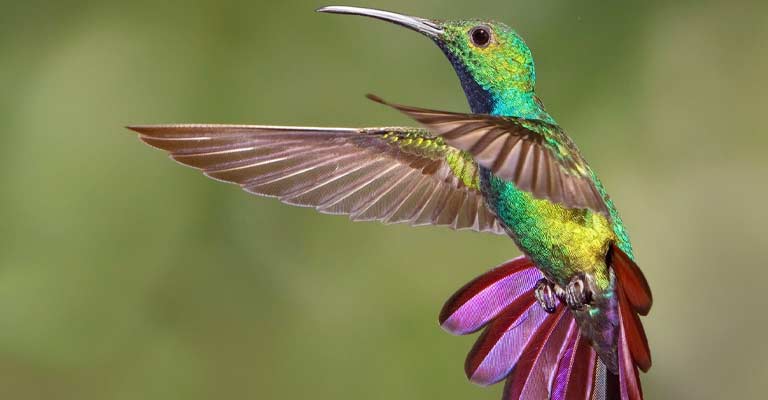
With a lustrous green chest, the Green-breasted Mango is a dazzling hummingbird species residing in Central America and northern South America. Its iridescent colors and swift flight captivate observers.
3. Puerto Rican Mango
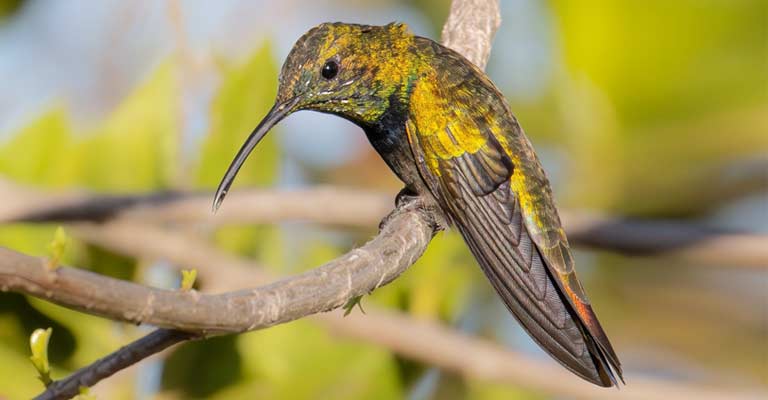
Endemic to Puerto Rico, the Puerto Rican Mango showcases a unique blend of green and purple hues. Its presence in the island’s forests adds to the enchanting biodiversity.
4. Rivoli’s Hummingbird
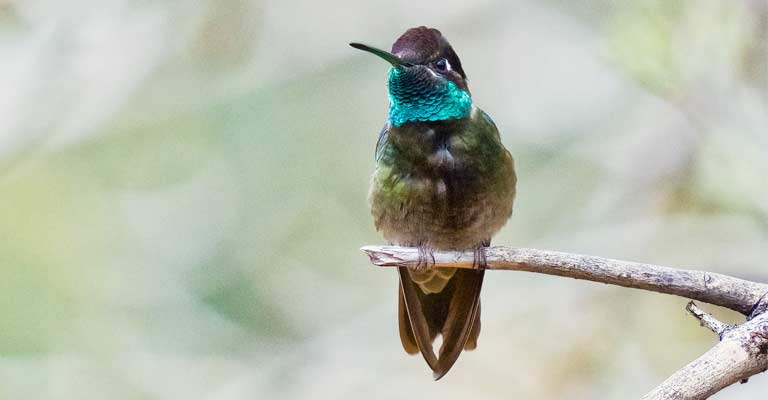
Rivoli’s Hummingbird, or Magnificent Hummingbird, boasts resplendent iridescence. Inhabitants of western North America are known for their large size and bold, shimmering plumage.
5. Plain-capped Starthroat
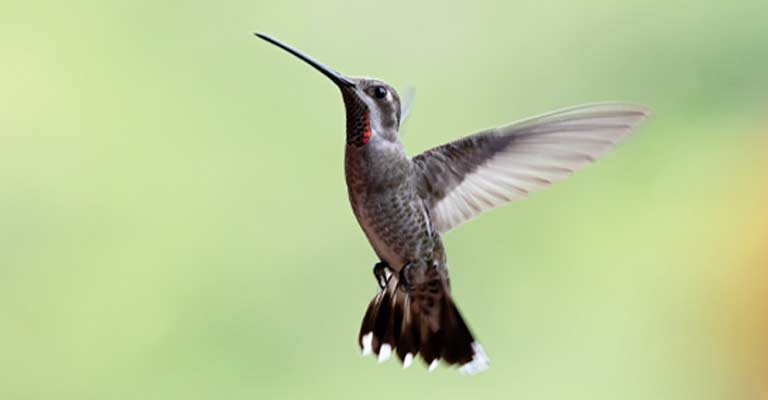
The Plain-capped Starthroat, an elegant species, exhibits a distinctive plain cap on its head. This hummingbird in Central and South America frequents open woodlands and gardens.
6. Amethyst-throated Mountain Gem
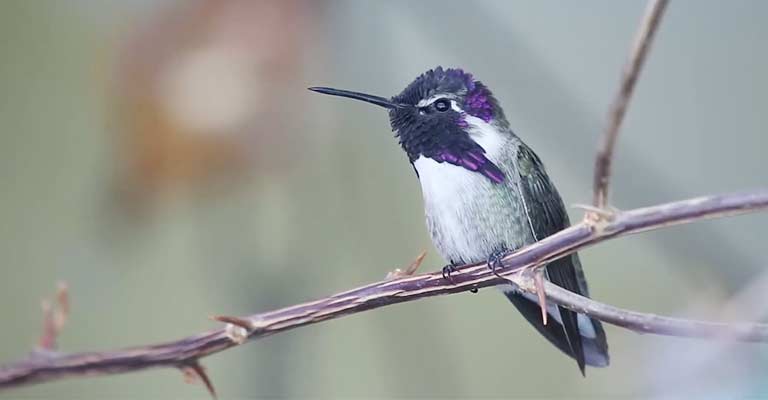
Residing in Central America, the Amethyst-throated Mountain Gem captivates with its amethyst-colored throat. It gracefully hovers, extracting nectar from colorful blossoms in its montane habitat.
7. Blue-throated Mountain-gem
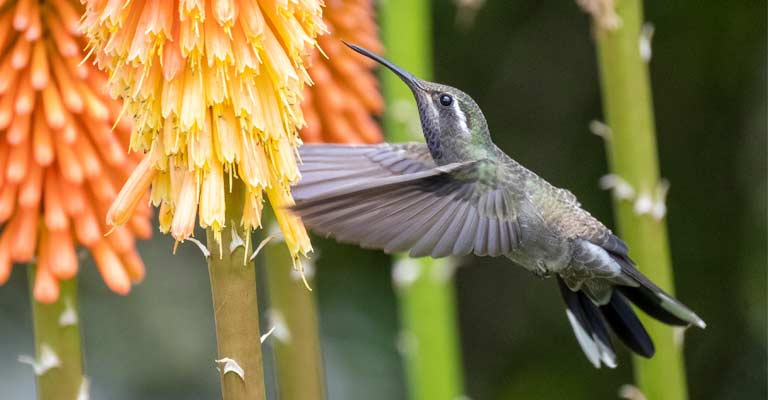
A native of Central America, the Blue-throated Mountain-gem displays a stunning blue throat. Its presence in montane forests contributes to the biodiversity of these high-altitude ecosystems.
8. Bahama Woodstar
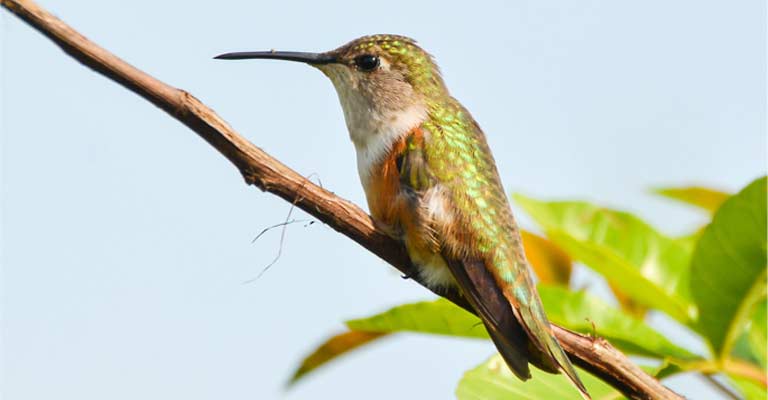
The Bahama Woodstar, a tiny hummingbird species, inhabits the Bahamas and Turks and Caicos Islands. Its compact size and iridescent plumage bring charm to these Caribbean locales.
9. Lucifer Hummingbird
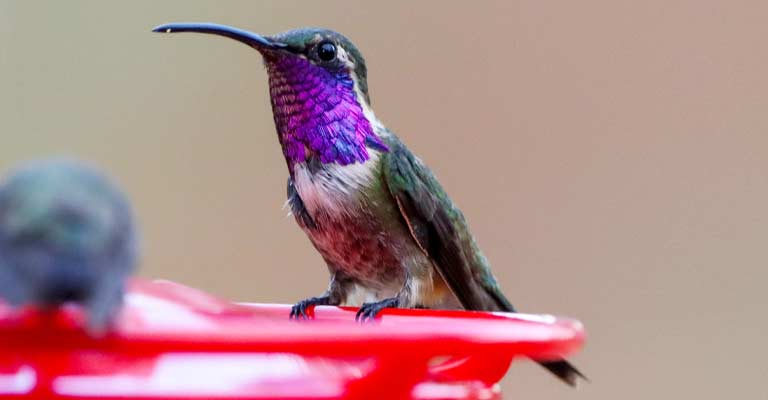
The Lucifer Hummingbird, named for its radiant plumage, inhabits arid regions of the southwestern United States and Mexico. Males display striking violet crowns, making them a captivating sight in their natural habitat.
10. Ruby-throated Hummingbird
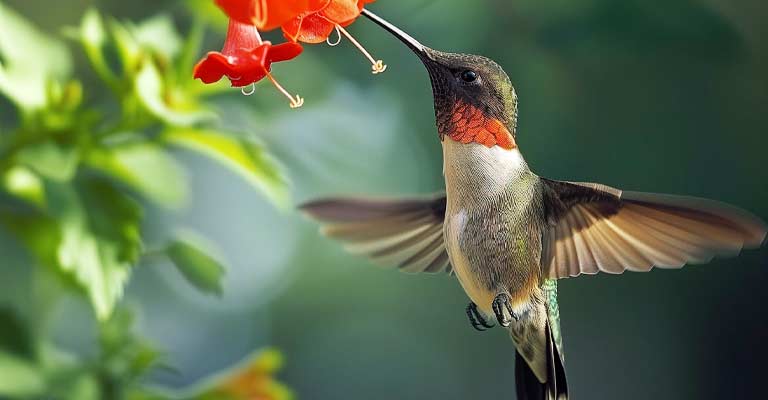
The Ruby-throated Hummingbird in eastern North America boasts vibrant green plumage, with males showcasing a brilliant ruby-red throat. These agile birds are renowned for their remarkable migratory feats.
11. Black-chinned Hummingbird
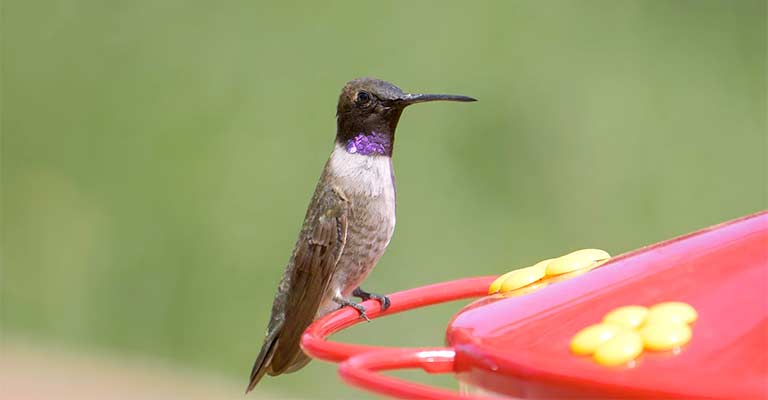
Inhabiting western North America, the Black-chinned Hummingbird is recognized by its iridescent black throat patch. These medium-sized hummingbirds exhibit agility in flight and often dominate specific territories during the breeding season.
12. Vervain Hummingbird
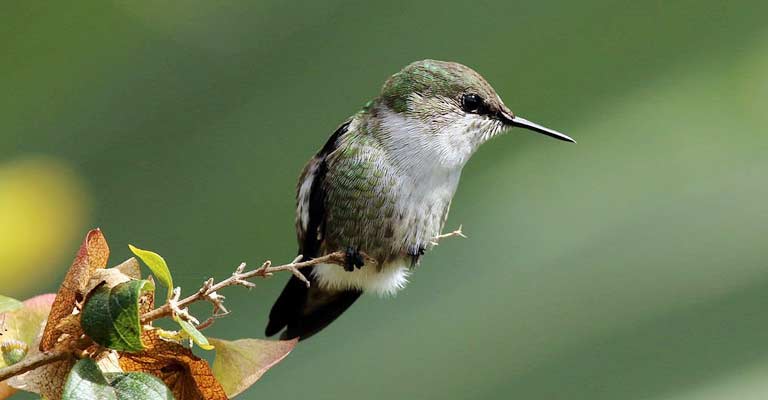
Endemic to Hispaniola, the Vervain Hummingbird features striking blue-green plumage. These small, enchanting birds are named after the vervain flowers they frequent, displaying an ecological interdependence with their floral habitats.
13. Anna’s Hummingbird
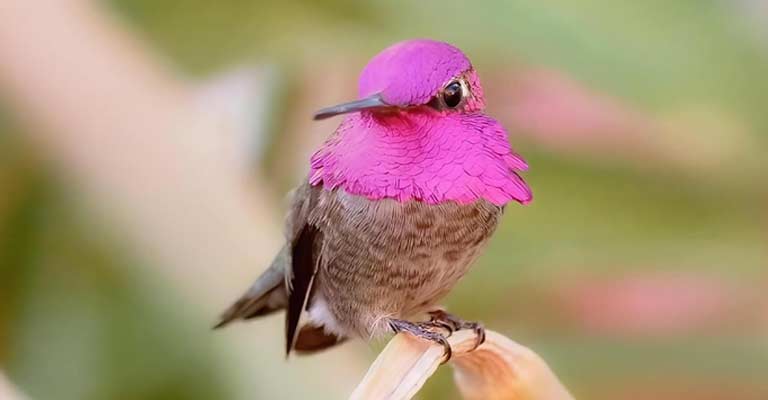
Native to western North America, Anna’s Hummingbird stands out with its iridescent green and rose-pink plumage. Notably, these hummingbirds are non-migratory, adapting to their coastal habitats year-round.
14. Costa’s Hummingbird
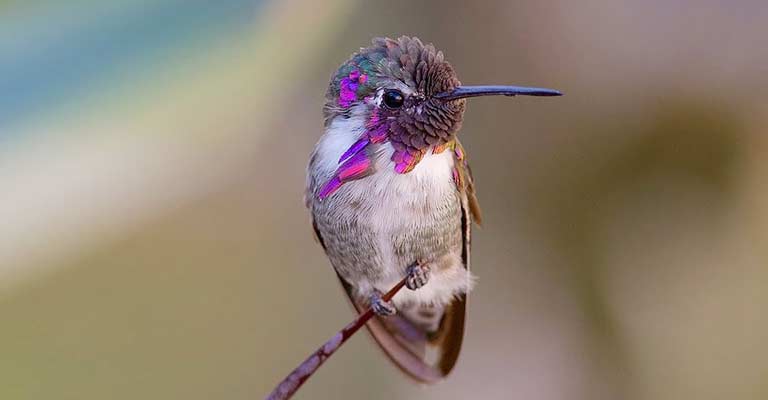
Found in the southwestern United States and Mexico, the Costa’s Hummingbird boasts a distinctive violet crown and throat. Their preference for arid desert habitats and distinct vocalizations characterize this captivating species.
15. Calliope Hummingbird
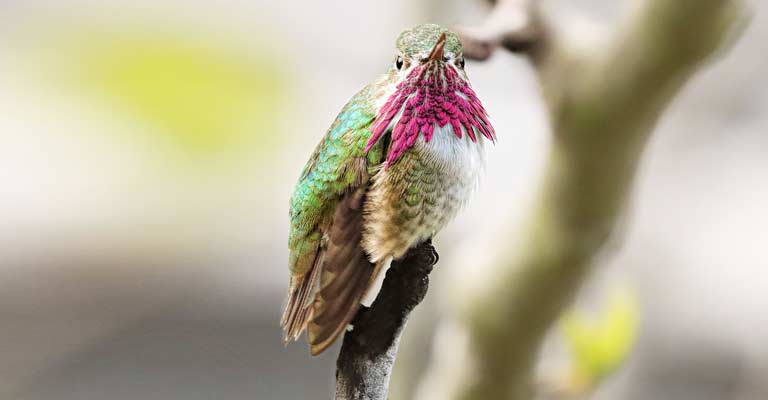
The smallest North American hummingbird, the Calliope Hummingbird, exhibits vibrant and intricate plumage. Nesting in mountainous regions, these birds embark on impressive migrations, showcasing remarkable endurance for their size.
16. Rufous Hummingbird
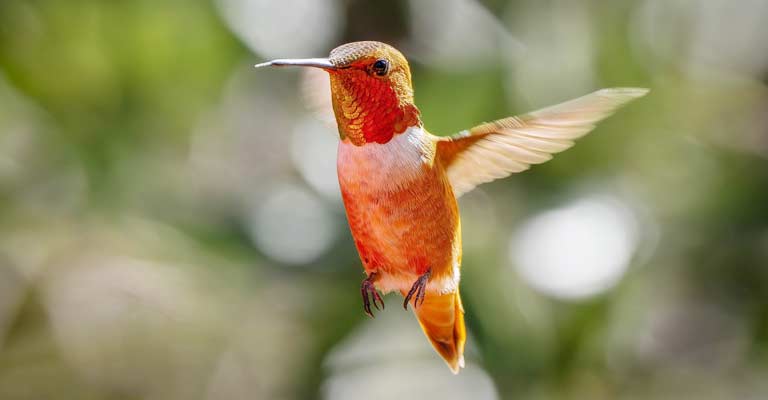
The Rufous Hummingbird, with its vibrant orange-red plumage and aggressive demeanor, migrates vast distances. Known for its aggressiveness, it fiercely defends its territory and delights observers with dazzling aerial displays.
17. Allen’s Hummingbird
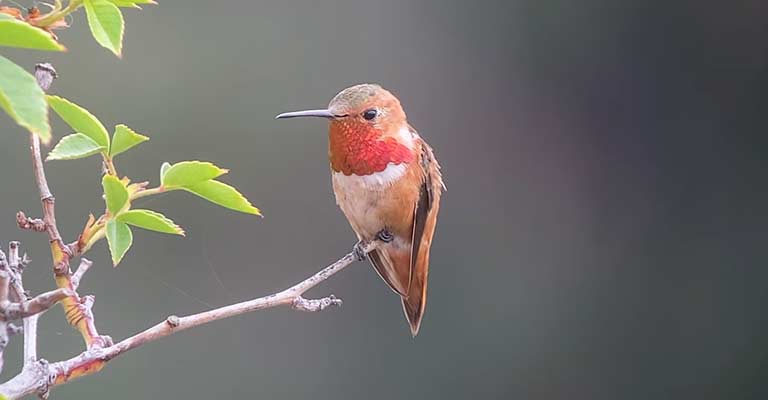
Allen’s Hummingbird, a relative to Rufous, boasts iridescent greens and reds. Its distinct “dive display” during courtship is a remarkable sight. Found along the western U.S. coast, it captivates with its beauty and charm.
18. Broad-tailed Hummingbird
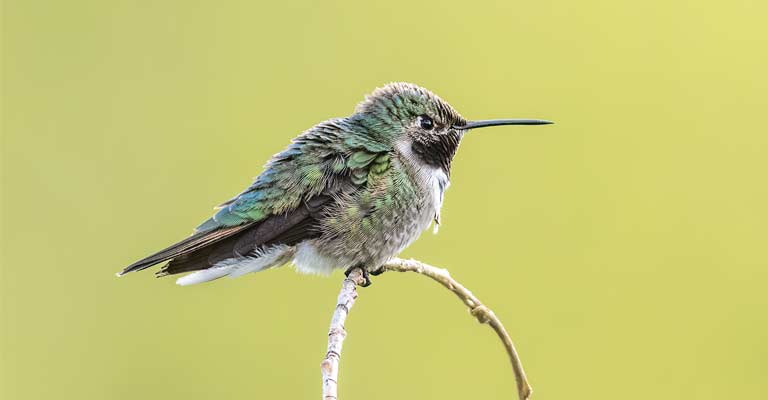
Distinguished by a striking metallic green color, the Broad-tailed Hummingbird thrives in mountainous habitats. Its high-altitude breeding grounds and unique trilling sounds make it a remarkable and harmonious presence in North America.
19. Bumblebee Hummingbird
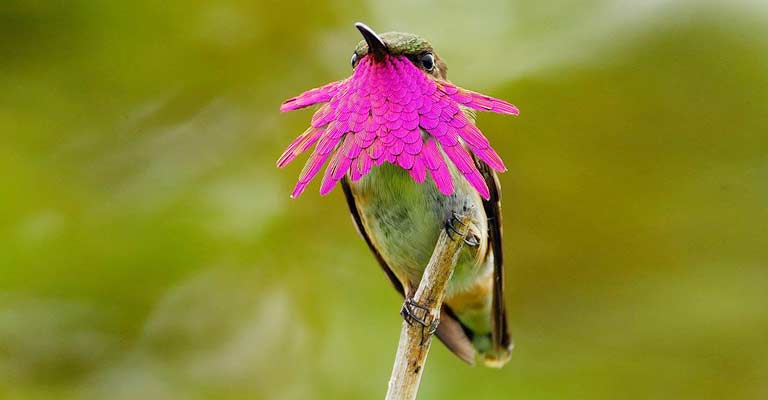
Weighing less than a nickel, the Bumblebee Hummingbird is the tiniest bird globally. Its iridescent plumage and swift, darting flights in Mexico and parts of the Americas make it a delightful and elusive gem.
20. Puerto Rican Emerald
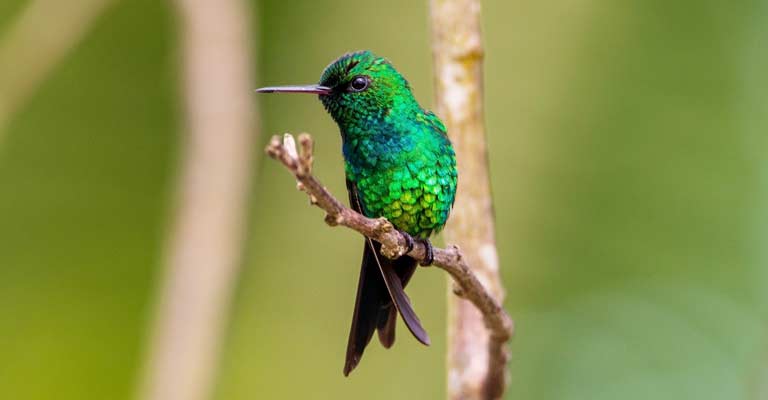
Endemic to Puerto Rico, the Puerto Rican Emerald showcases vibrant green plumage. Threatened by habitat loss, conservation efforts aim to protect this hummingbird’s unique island habitat, emphasizing its importance in preserving biodiversity.
21. Broad-billed Hummingbird
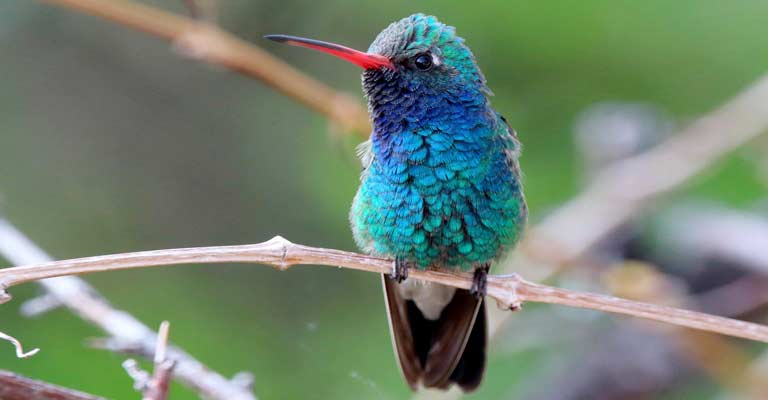
With its iridescent blue-green throat and comprehensive bill, the Broad-billed Hummingbird thrives in arid regions of the southwestern U.S. and Mexico. Its agile flights and affinity for nectar-rich blooms define its charm.
22. White-eared Hummingbird
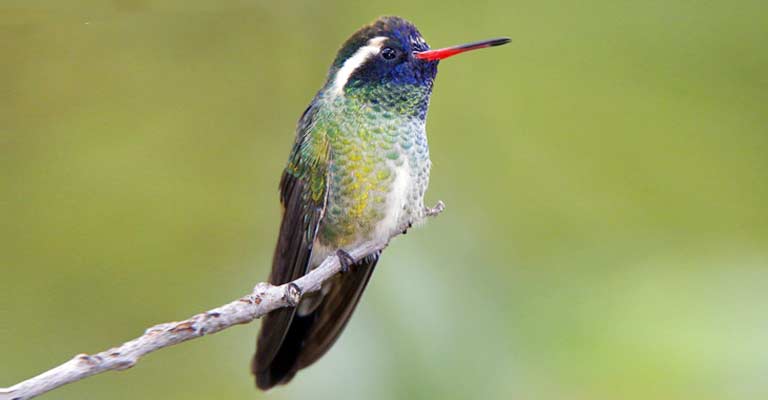
The White-eared Hummingbird, distinguished by a white stripe behind its eye, thrives in mountainous regions. Its iridescent green plumage and agile flight make it a captivating species in Central America.
23. Xantus’s Hummingbird
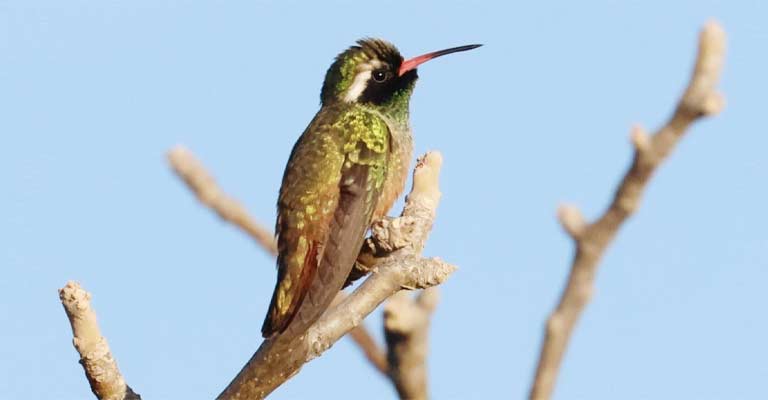
Xantus’s Hummingbird, native to Baja California, boasts a vibrant palette of green and copper hues. Its distinctive long bill and aggressive territorial behavior set it apart.
24. Antillean Crested Hummingbird

Endemic to the Caribbean, the Antillean Crested Hummingbird flaunts a striking crest. Its iridescent green feathers and intricate display during courtship make it a tropical delight.
25. Violet-crowned Hummingbird
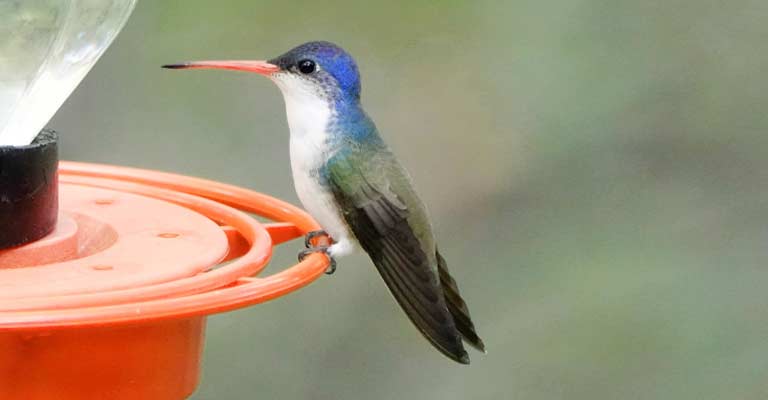
Found in the southwestern United States and Mexico, the Violet-crowned Hummingbird is distinguished by its regal violet crown. Its presence in arid habitats adds to its allure.
26. Berylline Hummingbird
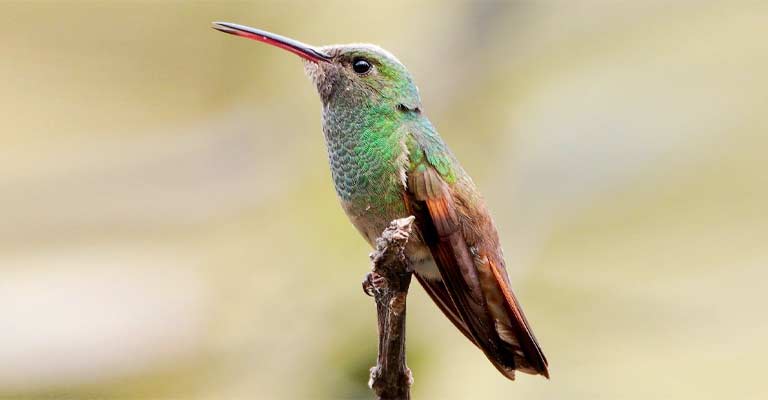
The Berylline Hummingbird, residing in Mexico and Central America, showcases subtle yet mesmerizing beryl-green plumage. Its unobtrusive elegance and feeding habits in flowering shrubs define its charm.
27. Cinnamon Hummingbird
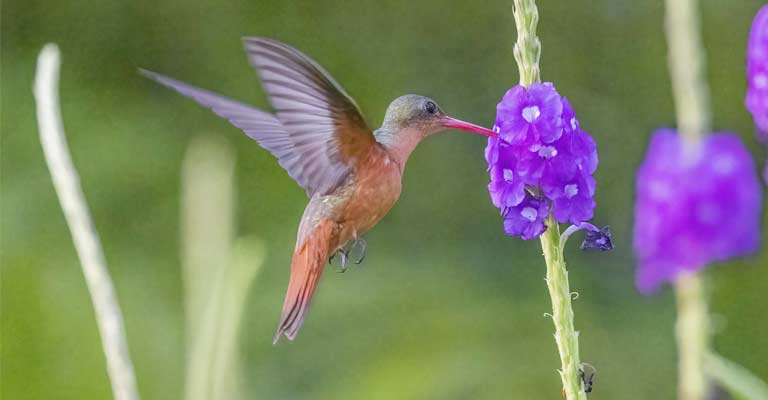
Endemic to Jamaica, the Cinnamon Hummingbird exhibits warm cinnamon-colored plumage. Its preference for lowland habitats and agile foraging make it a distinctive and adaptable species.
28. Buff-bellied Hummingbird
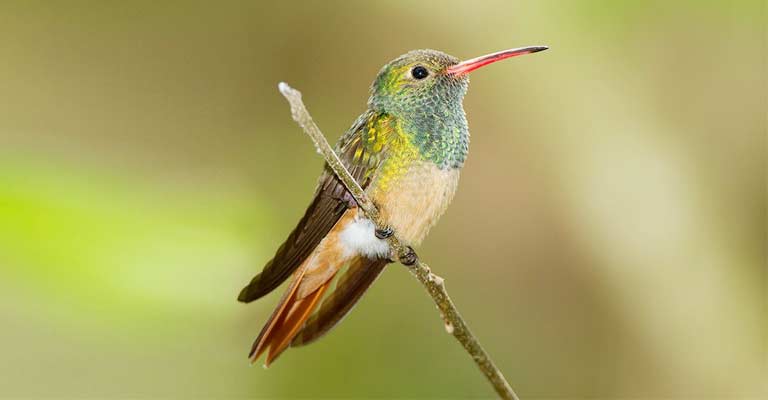
The Buff-bellied Hummingbird, a Gulf Coast resident, captivates with its buff-colored belly. Its coastal marsh and woodland habitat and distinctive markings render it an enchanting species.
Hummingbirds Life History
Among the most captivating avian species, Hummingbirds lead extraordinary lives marked by their dazzling plumage, remarkable flight, and specialized feeding habits.
This exploration of their life history will delve into crucial aspects such as their diet, habitat, range, nesting behavior, breeding practices, susceptibility to diseases, treatment options, and the importance of conservation efforts.
Food

The cornerstone of a hummingbird’s life revolves around its unique feeding habits.
Primarily nectar feeders, extract this sugary substance from various flowers using their specialized long, slender bills and extendable tubular tongues.
Hummingbirds also consume small insects and spiders to supplement their diet, providing essential proteins and nutrients.
Habitat
Hummingbirds inhabit diverse ecosystems, from lush tropical rainforests to arid deserts and alpine meadows.
Their adaptability allows them to thrive in various environments, but they are most commonly associated with areas rich in nectar-producing flowers, providing the sustenance they need.
Range Map
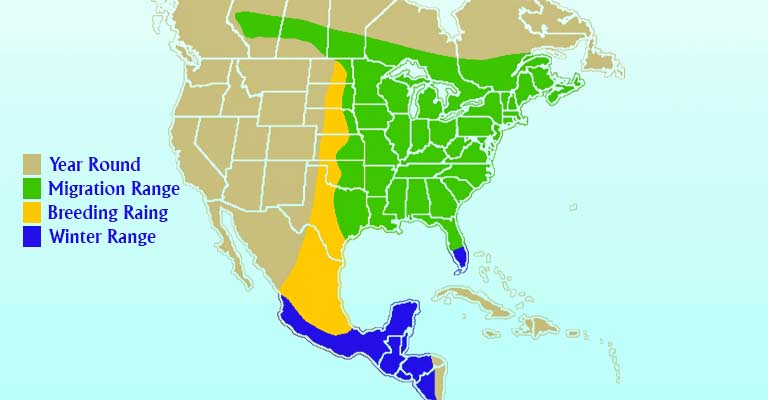
The range of hummingbirds is expansive, covering the Americas from Alaska to Tierra del Fuego. Each species has its preferred geographic area, influenced by climate, altitude, and floral abundance.
Range maps illustrate the distribution of various hummingbird species, highlighting their adaptability to diverse landscapes.
Nesting
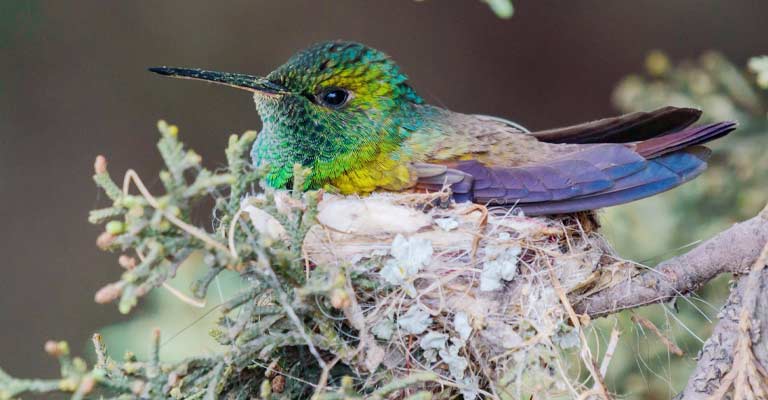
Nesting is a meticulous process for hummingbirds. Females construct tiny cup-shaped nests using materials like spider silk and plant fibers, camouflaging them with lichen or moss.
Nest placement varies, with some species choosing tree branches while others opt for sheltered locations like ledges.
Here’s a table summarizing nesting details of Hummingbirds:
| Nesting Details | Facts |
| Clutch Size | Typically 1 to 3 eggs, varying by species |
| Number of Broods | Female incubates and cares for chicks, and males may assist in feeding |
| Egg Length | Approximately 0.5 to 0.8 inches (1.3 to 2 cm) |
| Egg Width | Around 0.3 to 0.5 inches (0.8 to 1.3 cm) |
| Incubation Period | Ranges from 14 to 23 days, species-dependent |
| Nestling Period | Approximately 18 to 28 days, depending on the species |
| Egg Description | Tiny, elliptical, and often white or off-white |
| Nest Type | Cup-shaped, intricately woven with spider silk, moss, and plant fibers |
| Nest Location | Varied, including tree branches, ledges, and sheltered spots |
| Parental Care | Female incubates and cares for chicks, males may assist in feeding |
| Fledging Age | Chicks fledge when fully feathered and capable of flight |
Breeding
Hummingbirds engage in elaborate courtship displays, showcasing aerial acrobatics and vibrant plumage to attract mates.
Once a pair forms a bond, the female lays one or two eggs, which she incubates alone. After hatching, the chicks are fed a diet of regurgitated nectar and insects until they fledge.
Diseases
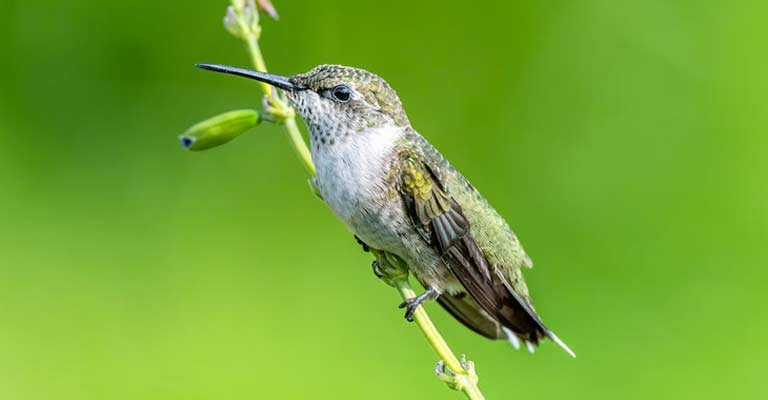
Hummingbirds, though resilient, can succumb to diseases, with common threats including fungal infections and parasites. Monitoring for signs of illness, such as lethargy or changes in feeding behavior, is crucial for early detection.
Treatment
Veterinary care for hummingbirds is a delicate process, often involving specialized diets, medication for infections, and careful observation.
Rehabilitation centers are vital in treating injured or ill hummingbirds, aiming to release them back into the wild once rehabilitated.
Conservation
Conservation efforts are paramount due to habitat loss, climate change, and other human-induced threats.
Protecting natural habitats, planting native flowering plants, and raising awareness about the importance of these pollinators are critical steps in ensuring the survival of hummingbird species.
The life history of hummingbirds is a tapestry woven with intricate feeding strategies, diverse habitats, and fascinating behaviors.
Understanding and appreciating the challenges they face underscores the urgency of conservation measures to secure the future of these enchanting and vital birds.
10 Fun Facts of Hummingbirds
Hummingbirds are captivating with their vibrant colors and aerial acrobatics and boast a range of fascinating characteristics. Here are some fun facts about these remarkable birds:
- Rapid Wing Beats: Hummingbirds can beat their wings incredibly fast, ranging from 50 to 80 beats per second. This allows them to hover in mid-air and move with remarkable agility.
- Unique Flight Abilities: Hummingbirds are the only birds that can fly backward. Their wings move in a figure-eight pattern, enabling them to hover, fly forwards, backward, and even upside down.
- High Metabolism: Hummingbirds have an exceptionally high metabolism. To sustain their energy levels, they must consume about half their body weight in sugar daily, primarily from nectar.
- Colorful Plumage: The vibrant colors of a hummingbird’s plumage are not due to pigments but to microscopic platelets in the feathers that refract light. This iridescence gives them an ever-changing appearance depending on the angle of the light.
- Memory Skills: Hummingbirds have excellent memories, allowing them to remember the locations of individual flowers and feeders. This helps them optimize their foraging routes and ensures a consistent supply of nectar.
- Courtship Displays: Male hummingbirds engage in elaborate courtship displays to attract females. These displays often involve aerial acrobatics, rapid dives, and the showcasing of vibrant plumage.
- Long Lifespan for Size: Given their small size and high metabolism, hummingbirds have a surprisingly long lifespan. Some species can live up to 9 years, although many succumb to predation, accidents, or harsh environmental conditions.
- Specialized Tongue: The hummingbird’s tongue is a marvel of engineering. Its long, tube-like structure allows them to lap up nectar rapidly. When not in use, the tongue retracts into the bird’s head.
- Excellent Vision: Hummingbirds have exceptional vision, enabling them to see a broad spectrum of colors, including ultraviolet light. This aids them in locating flowers and identifying potential mates.
- Unique Sleeping Position: During the night or periods of rest, hummingbirds enter a state of torpor, lowering their metabolic rate to conserve energy. They often perch on branches and assume a hunched position.
These fun facts highlight the extraordinary features and behaviors that make hummingbirds one of the most captivating and unique bird species in the avian world.
Wrapping Up
In the intricate tapestry of nature, hummingbirds stand out as tiny, iridescent jewels, enchanting observers with their vibrant colors, remarkable flight, and fascinating behaviors.
From their rapid wing beats to the delicate construction of their nests, hummingbirds exemplify nature’s artistry. Their migratory journeys, courtship displays, and high-energy lifestyles paint a picture of resilience and adaptability.
As we explore the hummingbird’s world, from their unique feeding habits to their crucial role in pollination, we gain a deeper appreciation for these diminutive yet extraordinary avian wonders.
By understanding their life history, nesting intricacies, and challenges, we become stewards of their conservation, ensuring that future generations can continue to marvel at hummingbirds’ dazzling beauty and captivating charm.